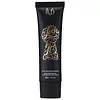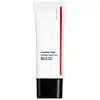What's inside
What's inside
 Key Ingredients
Key Ingredients

 Benefits
Benefits

 Concerns
Concerns

 Ingredients Side-by-side
Ingredients Side-by-side

Water
Skin ConditioningDimethicone/Vinyl Dimethicone Crosspolymer
Skin ConditioningOryza Sativa Bran Water
MaskingPolyglyceryl-3 Laurate
EmulsifyingCarbomer
Emulsion StabilisingGlycerin
HumectantIsostearyl Hydroxystearate
EmollientPhenoxyethanol
PreservativeSodium Hydroxide
BufferingC12-14 Pareth-12
EmulsifyingLens Esculenta Fruit Extract
Skin ConditioningCaprylyl Glycol
EmollientEthylhexylglycerin
Skin ConditioningAlgae Extract
EmollientGlycine Soja Oil
EmollientSodium Benzoate
MaskingPotassium Sorbate
PreservativeChlorella Vulgaris/Lupinus Albus Protein Ferment
Skin ConditioningTocopherol
AntioxidantWater, Dimethicone/Vinyl Dimethicone Crosspolymer, Oryza Sativa Bran Water, Polyglyceryl-3 Laurate, Carbomer, Glycerin, Isostearyl Hydroxystearate, Phenoxyethanol, Sodium Hydroxide, C12-14 Pareth-12, Lens Esculenta Fruit Extract, Caprylyl Glycol, Ethylhexylglycerin, Algae Extract, Glycine Soja Oil, Sodium Benzoate, Potassium Sorbate, Chlorella Vulgaris/Lupinus Albus Protein Ferment, Tocopherol
Water
Skin ConditioningMethyl Trimethicone
Skin ConditioningButylene Glycol
HumectantMethyl Methacrylate Crosspolymer
Dimethicone
EmollientPEG-10 Dimethicone
Skin ConditioningTriethylhexanoin
MaskingDiphenylsiloxy Phenyl Trimethicone
Skin ConditioningPolymethylsilsesquioxane
Caprylyl Methicone
Skin ConditioningTrifluoropropyldimethyl/Trimethylsiloxysilicate
EmollientCI 77120
Cosmetic ColorantSodium Chloride
MaskingDisteardimonium Hectorite
StabilisingPhenoxyethanol
PreservativeDisodium EDTA
Dipeptide-15
Skin ConditioningXanthan Gum
EmulsifyingChlorphenesin
AntimicrobialCellulose
AbsorbentCI 77891
Cosmetic ColorantMica
Cosmetic ColorantTocopherol
AntioxidantThymus Serpyllum Extract
Skin ConditioningDimethicone/PEG-10/15 Crosspolymer
Vinyl Dimethicone/Methicone Silsesquioxane Crosspolymer
Polyquaternium-51
Skin ConditioningStearic Acid
CleansingAluminum Hydroxide
EmollientZinc Oxide
Cosmetic ColorantHydrolyzed Conchiolin Protein
Skin ConditioningDimethicone/Vinyl Dimethicone Crosspolymer
Skin ConditioningAlumina
AbrasiveDipropylene Glycol
HumectantWater, Methyl Trimethicone, Butylene Glycol, Methyl Methacrylate Crosspolymer, Dimethicone, PEG-10 Dimethicone, Triethylhexanoin, Diphenylsiloxy Phenyl Trimethicone, Polymethylsilsesquioxane, Caprylyl Methicone, Trifluoropropyldimethyl/Trimethylsiloxysilicate, CI 77120, Sodium Chloride, Disteardimonium Hectorite, Phenoxyethanol, Disodium EDTA, Dipeptide-15, Xanthan Gum, Chlorphenesin, Cellulose, CI 77891, Mica, Tocopherol, Thymus Serpyllum Extract, Dimethicone/PEG-10/15 Crosspolymer, Vinyl Dimethicone/Methicone Silsesquioxane Crosspolymer, Polyquaternium-51, Stearic Acid, Aluminum Hydroxide, Zinc Oxide, Hydrolyzed Conchiolin Protein, Dimethicone/Vinyl Dimethicone Crosspolymer, Alumina, Dipropylene Glycol
Ingredients Explained
These ingredients are found in both products.
Ingredients higher up in an ingredient list are typically present in a larger amount.
This ingredient is a silicone used to improve the texture of products and absorb oil. It does not get absorbed into the skin.
Like other silicones, Dimethicone/Vinyl Dimethicone Crosspolymer helps condition the skin by creating a barrier. In this sense, it can act as an emollient and trap moisture in.
This ingredient is a type of elastomer.
Learn more about Dimethicone/Vinyl Dimethicone CrosspolymerPhenoxyethanol is a preservative that has germicide, antimicrobial, and aromatic properties. Studies show that phenoxyethanol can prevent microbial growth. By itself, it has a scent that is similar to that of a rose.
It's often used in formulations along with Caprylyl Glycol to preserve the shelf life of products.
Tocopherol (also known as Vitamin E) is a common antioxidant used to help protect the skin from free-radicals and strengthen the skin barrier. It's also fat soluble - this means our skin is great at absorbing it.
Vitamin E also helps keep your natural skin lipids healthy. Your lipid skin barrier naturally consists of lipids, ceramides, and fatty acids. Vitamin E offers extra protection for your skin’s lipid barrier, keeping your skin healthy and nourished.
Another benefit is a bit of UV protection. Vitamin E helps reduce the damage caused by UVB rays. (It should not replace your sunscreen). Combining it with Vitamin C can decrease sunburned cells and hyperpigmentation after UV exposure.
You might have noticed Vitamin E + C often paired together. This is because it is great at stabilizing Vitamin C. Using the two together helps increase the effectiveness of both ingredients.
There are often claims that Vitamin E can reduce/prevent scarring, but these claims haven't been confirmed by scientific research.
Learn more about TocopherolWater. It's the most common cosmetic ingredient of all. You'll usually see it at the top of ingredient lists, meaning that it makes up the largest part of the product.
So why is it so popular? Water most often acts as a solvent - this means that it helps dissolve other ingredients into the formulation.
You'll also recognize water as that liquid we all need to stay alive. If you see this, drink a glass of water. Stay hydrated!
Learn more about Water